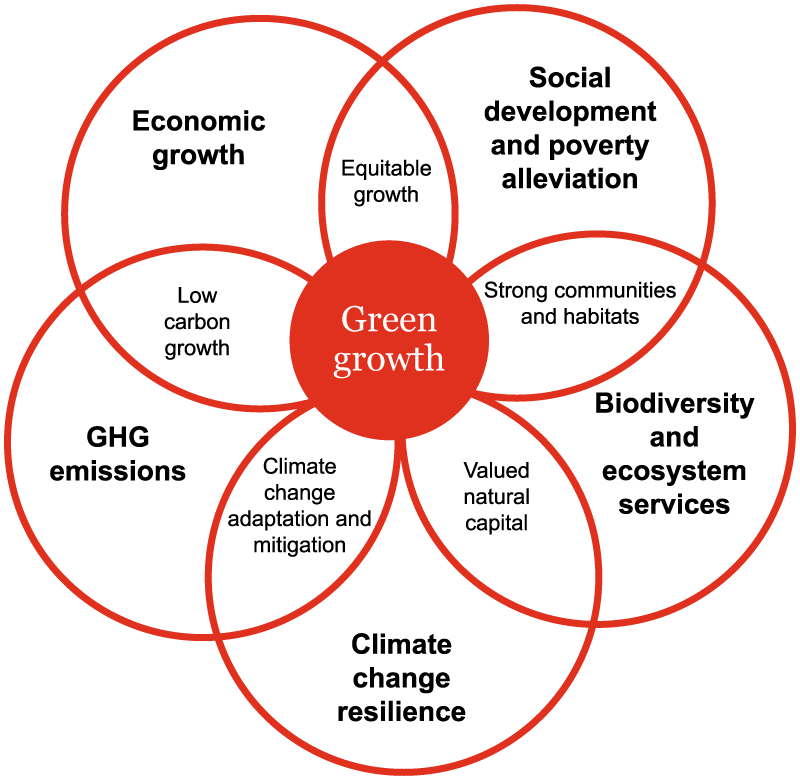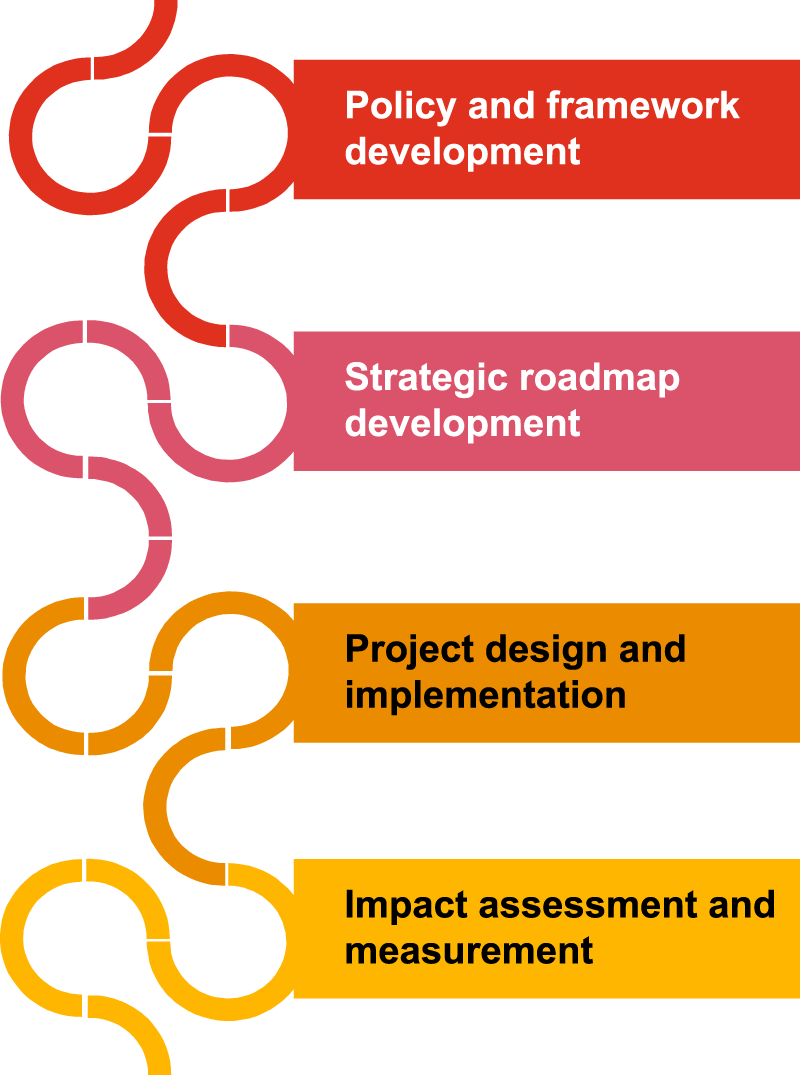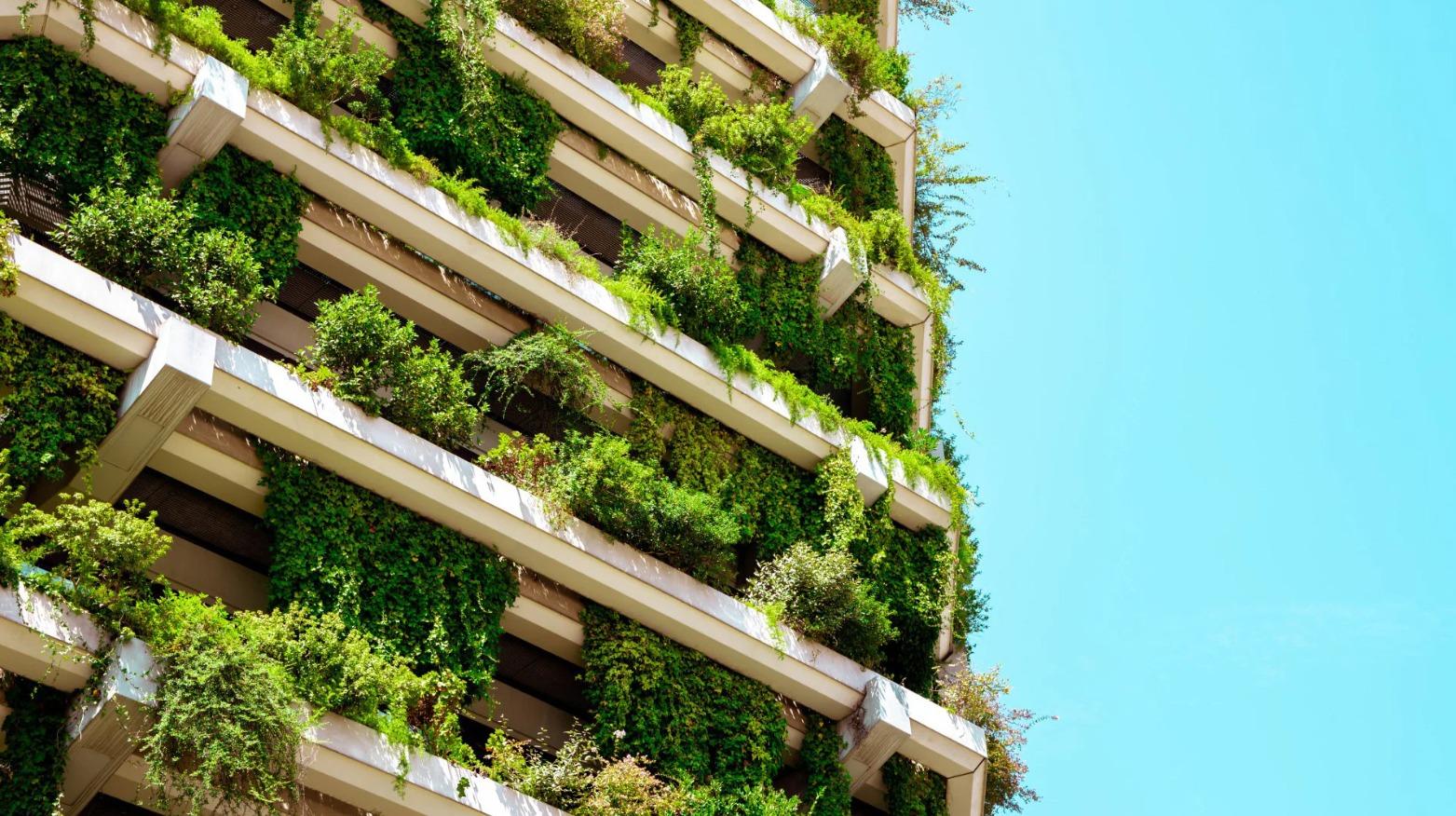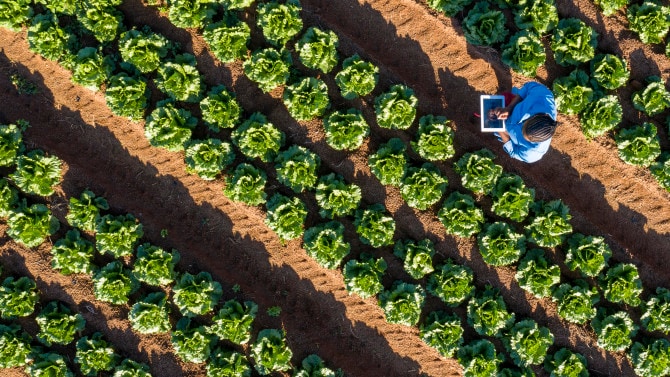Green growth in Southeast Asia’s public sector
February 10, 2023
What is green growth?
According to the Organisation for Economic Cooperation and Development (OECD), green growth represents a paradigm shift from our existing approach towards economic growth, focusing on how countries can sustainably utilise their natural resources to achieve their economic and social goals. Beyond economic growth, green growth also measures other kinds of progress, like improved human well-being and social equity, in order to comprehensively capture all aspects of economic performance.
What does green growth mean for Southeast Asia?
Dimensions of green growth
Green growth in employment and income are driven by public and private investment into economic activities, infrastructure and assets that allow reduced carbon emissions and pollution, enhanced energy and resource efficiency, prevention of the loss of biodiversity and ecosystem services, and improved social equity. The dimensions of green growth adapted from a framework in the PwC and WWF1 publication include:

Economic growth is important for social development and prosperity and must be considered in conjunction with other environmental and social factors. As one of the highest growth regions in the world, Southeast Asia could lose 11% of its GDP in 2100 if it were to continue the business-as-usual scenario.2
Social development and poverty alleviation is a central objective of green growth and is highly correlated with economic growth and environmental quality. Green growth could help Southeast Asia to continue its significant poverty reduction efforts and recover from COVID-19 setbacks where 4.7 million people were pushed into extreme poverty.3
Greenhouse gas emissions need to be limited to contribute to global and national net zero goals and minimise future adverse impacts on the climate. Green growth could mitigate the region’s greenhouse gas emissions, which have increased by 5% per year over recent decades due to rapid deforestation and fossil fuel usage.4
Biodiversity and ecosystem services provide valuable contributions to economic growth and human welfare but are often omitted from decision making. Green growth seeks to consider these externalities and could help Southeast Asia to reap economic benefits from its biodiversity, estimated to be US$2.19 trillion per year.5
Climate change resilience is about adapting to the physical impacts of a changing climate. Green growth could mainstream climate adaptation and enhance the resilience of the region and its 77% of the population living in coastal areas.6
Drivers and benefits of green growth
The following factors have driven increasing green economy opportunities in Southeast Asia:
Scale of international commitment on net zero and low carbon agenda
Growing significance of biodiversity conservation and restoration
Need to accelerate economic growth post COVID-19 pandemic
Increasing market demand for low carbon and environmental goods and services
Proliferation of green economy initiatives including the sustainable use of natural capital
Rising importance in building resilient societies and ensuring just transition
The benefits of pursuing green growth:
- Accelerate economy recovery after the COVID-19 downturn
- Contribute to meeting climate goals and enhance climate resilience
- Realise the economic value of natural capital
- Provide inclusive economic opportunities for wider society
Enablers for a green economy transition
One of the best ways for countries in the region to transition to a green economy involves balancing economic growth with a responsible approach towards utilisation of natural resources, accompanied with an integration of climate adaptation and mitigation plans. Ensuring the presence of financing mechanisms is important for enabling green growth. This could happen through removing subsidies (e.g. fossil fuels), or introducing environmental taxes and mobilising private sector funding. Beyond financials, the transition to a green economy could be accelerated by the following enablers.
Key challenges in adopting green growth policies
Transition towards green growth is not without obstacles. Benefits of the green economy may only be appreciated when environmental externalities are addressed through full-cost pricing. This would influence decision making on prioritising the right activities contributing to green growth. In adopting green growth frameworks that introduce green growth policies, countries face a number of common challenges and issues such as:
Insufficient knowledge and inadequate capability to integrate environmental matters into development plan.
Lack of data to understand baseline and assess priorities to customise green growth policies aligned with the region’s needs.
Competing priorities between affordable basic needs and incorporating green goals which can be more costly.
Lack of business case for change as the long term benefits are undervalued compared to immediate benefits of traditional routes.
Lack of financial resources to enable shift towards green growth including investment in renewable energy infrastructure.
Heavy focus on climate change or energy policies leaving out other important issues e.g. biodiversity, forest conservation, social aspects, and water.
How we can support you?

Policy and framework development
- Review existing green growth policies and financing options
- Identify gaps in the current policies, potential challenges and opportunities
- Identify and prioritise key areas of interventions
- Develop policy frameworks (e.g. green growth and carbon trading policies)
- Formulate implementable policy recommendations leveraging on good practices, adaptable experience from other countries
- Navigate inter-linkages between the various aspects of the green growth
Strategic roadmap development
- Assess the readiness to adopt green growth and propose recommendations to enhance readiness
- Develop strategic roadmap to support the low carbon targets
- Provide recommendations for adoption, including policies pertaining to each key pillar identified and action plan, to benefit the environment and socio-economy
Project design and implementation
- Project support from design phase to monitoring and evaluation phase
- Identify potential low carbon projects e.g. renewable energy, forestry, participation in compliance and voluntary carbon markets
- Develop guidance on participation in compliance or voluntary carbon markets
- Stakeholder communication and engagement to a wide range of stakeholders including public and private sector, CSOs, NGOs, and development partners
- Develop governance and monitoring framework to track the achievements of implementation of the programme
- Provide capacity building and capacity support in any of the phase
Impact assesmsent and measurement
- Develop impact assessment framework including the guiding principles
- Set the evaluation methodology and prioritisation criteria
- Assess and measure the impact of the interventions
- Establish balance between near-term metrics and sustained outcomes
Case study: Green economy policy and carbon trading strategy framework for a state in Southeast Asia
Context: The State has the largest area of forest cover in the country and aims to attract green financing through development of carbon offset schemes leveraging on its natural resources.
The overarching Green Economy policy and Carbon Trading Strategy framework provided recommendations of suitable green economy policies for adoption and set the priorities and targets for the State towards addressing key challenges to green the State’s traditional sectors by reducing greenhouse gas emissions and promoting resource efficiency while also capturing economic opportunities and generating jobs in new green sectors.
Outcome: PwC has supported the State by identifying priority areas for their green economy and performed comparative analysis to identify best practices and economy wide and sectoral recommendations for adoption. At the end of the study, 31 recommendations across six key pillars i.e. Energy; Transport and Mobility; Land Use, Nature and Biodiversity; Waste and Water; Industry; Low Carbon Cities were identified with detailed implementation plans outlined.
We also provided the State with the baseline of carbon emissions, based on national GHG inventory, to set a target of emission reduction in key sectors. We developed a governance framework to implement and monitor the proposed initiatives of this project and a carbon trading policy framework as a recommendation to develop carbon trading projects.
References
1 PwC, and WWF. “Roadmap for a Green Economy in the Heart of Borneo: a Scoping Study,” 2011.
2 Raitzer, D., Bosello, F., and Tavoni, M. “Southeast Asia and the Economics of Global Climate Stabilization.” Asian Development Bank, 2015.
3 Asian Development Bank. “Covid-19 Pushed 4.7 Million More People in Southeast Asia into Extreme Poverty in 2021, but Countries Are Well Positioned to Bounce Back.”, 2022.
4 Raitzer, D., Bosello, F., and Tavoni, M. “Southeast Asia and the Economics of Global Climate Stabilization.” Asian Development Bank , 2015.
5 Auto, H. “South-East Asia's Biodiversity Worth $3 Trillion a Year in Economic Growth, Jobs: Report.” The Straits Times, 2022.
6 PEMSEA. “Sustainable Development Strategy for the Seas of South East Asia”. 2015.
7 Asian Development Bank. “Implementing a Green Recovery in Southeast Asia.” 2022.
8 Auto, H. “Companies Can Do More to Bridge South-East Asia's Green Financing Gap: Panel.” The Straits Times, 2021.

















